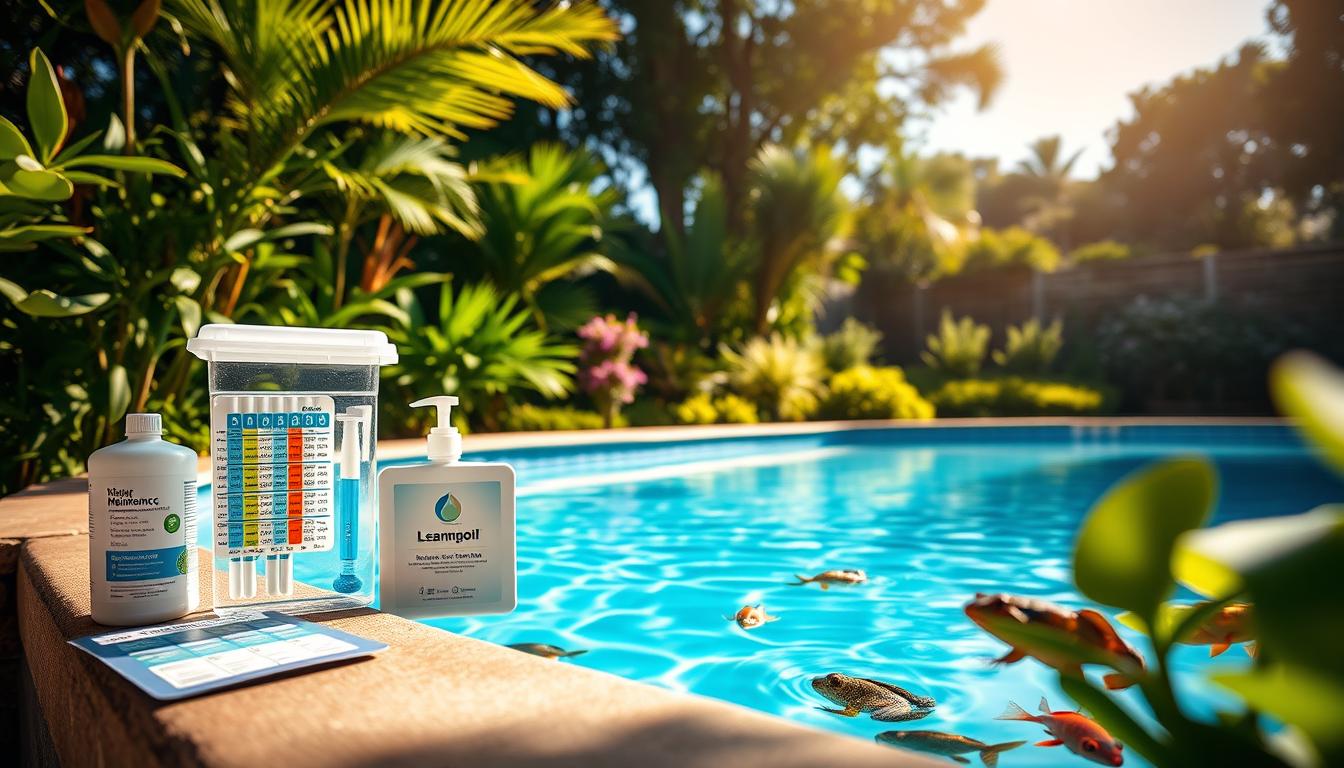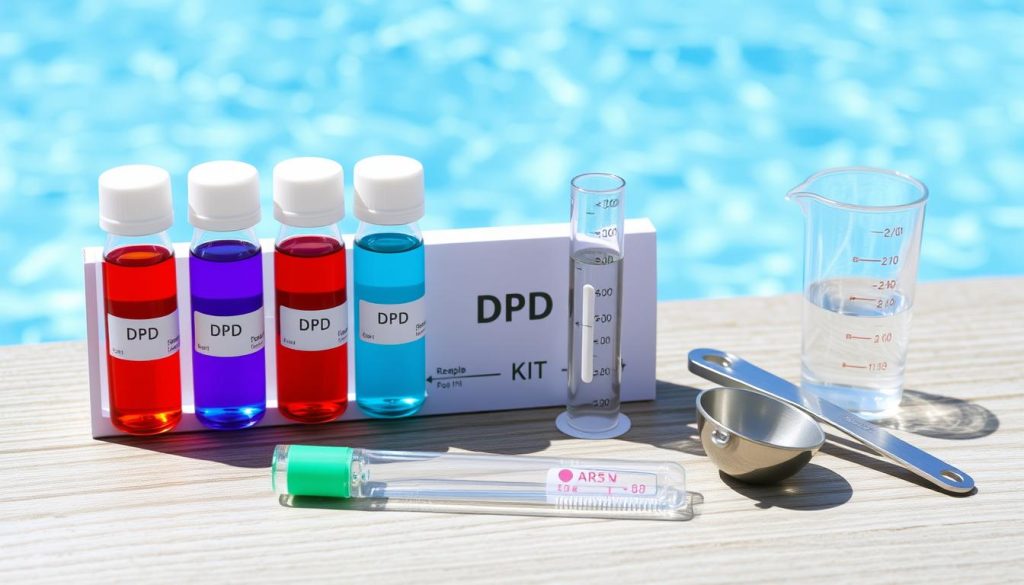
High chlorine levels in pools can be dangerous. The ideal range is 1.0 to 3.0 ppm. Excess chlorine can irritate skin, eyes, and lungs.
It may also damage pool equipment over time. Maintaining proper chlorine balance is vital for swimmer safety. Let’s explore how to lower total chlorine in your pool effectively.
Key Takeaways:
- Ideal chlorine levels in a pool should be between 1.0 and 3.0 ppm for safe swimming.
- High chlorine levels can cause health issues and damage pool equipment.
- Regular pool water testing is essential to monitor chlorine levels.
- Methods to lower total chlorine include stopping chlorine addition, using a chlorine reducer, partially draining and refilling the pool, and utilizing sun and wind exposure.
- Understanding the difference between free chlorine and combined chlorine is crucial for proper pool maintenance.
Understanding Chlorine Levels in Your Pool
Proper chlorine balance in your pool ensures safe and enjoyable swimming. Chlorine sanitizes pool water, keeping it clean and free from harmful bacteria. Different types of chlorine require specific levels for optimal water quality.
Ideal Chlorine Range for Safe Swimming
The ideal chlorine range for pools is one to three parts per million (ppm). This range keeps water sanitized without causing discomfort to swimmers. Regularly test your pool water with a reliable chlorine kit to maintain proper levels.
Dangers of High Chlorine Levels
Excessive chlorine can be harmful. Levels above three ppm may cause skin and eye irritation. In extreme cases, high chlorine can lead to chlorine poisoning, causing serious health issues.
Maintaining recommended chlorine levels is crucial to avoid these risks. Regular testing helps keep your pool safe for everyone.
Free Chlorine vs. Combined Chlorine
Free chlorine actively sanitizes pool water by neutralizing bacteria and contaminants. Combined chlorine, or chloramines, forms when free chlorine mixes with sweat, oils, and urine.
Combined chlorine can cause unpleasant odors and reduce sanitizing effectiveness. Keeping combined chlorine low and free chlorine adequate ensures optimal water quality.
Here are the ideal ranges for different chlorine types:
| Chlorine Type | Ideal Range (ppm) |
|---|---|
| Free Chlorine | 2.0 – 4.0 |
| Combined Chlorine | < 0.2 |
| Total Chlorine | Aligned with Free Chlorine |
Regular pool water testing helps manage chlorine levels effectively. Understanding chlorine types ensures a safe and inviting swimming environment for everyone.
Testing Your Pool Water for Excessive Chlorine
Pool water testing is vital for a safe swimming environment. High chlorine can irritate skin and eyes. Regular testing keeps chlorine levels ideal.

Using a DPD Testing Kit
DPD testing kits accurately measure pool chlorine levels. They use a chemical that reacts with chlorine, changing color. This shows the chlorine concentration.
Here’s how to use a DPD testing kit:
- Fill the test tube with pool water.
- Add the DPD reagent or tablet to the water sample.
- Swirl the test tube to dissolve the reagent.
- Compare the water color to the chart to determine chlorine level.
DPD kits are easy to use and widely available. They’re great for pool owners maintaining optimal chlorine levels.
Interpreting Test Results
Understanding your test results is crucial. Here’s the ideal chlorine range for a healthy pool:
| Chlorine Type | Optimal Range (ppm) |
|---|---|
| Free Chlorine | 2.0 – 4.0 |
| Combined Chlorine | Less than 0.2 |
| Total Chlorine | Approximately equal to Free Chlorine |
Free chlorine above 4.0 ppm indicates excessive levels. Combined chlorine over 0.2 ppm is also too high. If this happens, lower the chlorine concentration.
Regularly testing your pool water and interpreting the results correctly are key to maintaining a safe and healthy swimming environment for you and your loved ones.
Use a DPD kit to monitor chlorine levels. This ensures clear water and a great swim all season.
Methods to Lower Total Chlorine in Your Pool
Is your pool’s chlorine level too high? Don’t worry! We have effective methods to fix this issue. Let’s explore ways to lower total chlorine in your pool safely and comfortably.
Stop Adding Chlorine
The easiest way to reduce high chlorine is to stop adding more. Remove chlorine tablets from floaters or dispensers. Let the existing chlorine dissipate naturally over a few days.
This works well if levels are slightly high. It’s a good option if you can wait patiently.
Use a Chlorine Reducer
For faster results, try a chlorine neutralizer like sodium thiosulfate. It reacts with chlorine to lower levels quickly. Always follow the manufacturer’s instructions carefully.
Proper dosage is crucial. Overdosing can cause other water chemistry issues. Proceed with caution when using this method.
“Sodium thiosulfate is a highly effective chlorine reducer that can quickly lower high chlorine levels in your pool. Just be sure to follow the dosage instructions carefully to avoid any potential issues.”
Partially Drain and Replenish Pool Water
You can partially drain your pool and add fresh, untreated water. This dilutes the high chlorine concentration. Remember to rebalance all pool chemicals after replacing water.
This ensures optimal water quality and clarity. It’s important when replacing a significant amount of pool water.
| Amount of Water Drained | Chlorine Reduction |
|---|---|
| 25% | 25% |
| 50% | 50% |
| 75% | 75% |
Utilize Sun and Wind Exposure
Outdoor pools can benefit from natural elements like sunlight and wind. UV rays break down free chlorine molecules. Wind encourages evaporation, which also helps lower chlorine levels.
This method is slower than others. However, it’s cost-effective and chemical-free. It works well with other chlorine reduction techniques.
Preventative Measures for Maintaining Optimal Chlorine Levels
Keeping pool water safe requires maintaining the right chlorine balance. Regular pool testing is crucial. Check your pool water weekly, especially during busy swimming seasons.
Using stabilized chlorine products with cyanuric acid helps protect chlorine from UV rays. This maintains more consistent chlorine levels. Keep cyanuric acid levels below 150 mg/litre to avoid chlorine lock.
Accurate pool volume calculation enables adding the right amount of chemicals. This prevents over-chlorination. Chlorine feeders dispense chlorine at a steady, controlled rate.
Feeder types include floating dispensers and automatic inline feeders. Offline erosion feeders are another option. Feeders help maintain ideal chlorine levels of 1-3 ppm without daily manual dosing.
Implementing these measures ensures a well-balanced, properly sanitized pool. Partnering with a trusted pool professional can provide additional guidance for pool maintenance.







